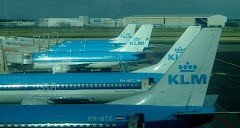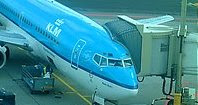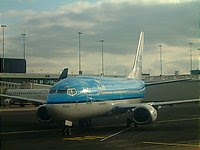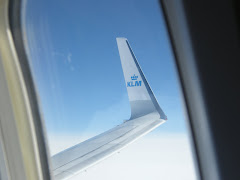Royal Dutch Airlines
KLM (Koninglijke Luchtvaart Maatschappij) is so far the oldest airline in the world still flying under its original name.
It was founded in 1919 and began operations in 1920. It was the time when civilian aviation companies were carrying only mail, those companies would start slowly carrying passengers in addition to the mail. This was how commercial aviation began. The airlines began to evolve as both passenger and mail hauling.
The first commercial flight took place in 1920 on a flight from London to Amsterdam with a De Havilland aircraft. The first Fokker aircraft was introduced in 1921. Fokker used to be a Dutch aircraft manufacturer so it was a natural move from KLM to operate Fokker aircraft. The network expanded to a few other European places, KLM continued to operate Fokker aircraft but it turned to the then American manufacturer Douglas as well. The first US built aircraft was the Douglas DC-2, followed by the legendary DC-3. Since then KLM always remained loyal to Douglas. However it turned to Lockheed as well with the purchase of new aircraft including the L-188 Electra and the L-1049 Constellation.
The first flight beyond Europe took place in the late 1920's. Service to Indonesia was inaugurated. Indonesia was colonized by the Dutch so it was normal that KLM's first long haul flight was scheduled to Indonesia. Curaçao and New York were added in 1934 and 1946 respectively. The last piston engine aircraft to be introduced before the jet age was the DC-7.
KLM entered the jet age in the early 1960's with the introduction of the Douglas DC-8 on long haul flights and it introduced the DC-9 on short and medium haul routes in the mid 1960's. I think that KLM's loyalty to Douglas explains why the Boeing 707 and 727 were never considered, neither was the Caravelle.
Until the first Boeing 747 was introduced in 1971, KLM had flown no Boeing aircraft. It was the time Boeing was showing to the airlines of the world its latest product that would revolutionize air travel, the widebody 747. KLM was interested in a Combi version of the 747-200B for its intercontinental flights. It was also at that time KLM introduced a new paint job: an all blue top on the fuselage with a dark blue cheatline, replacing the classic white top, leaving the tail painted in white and the same logo with the crown as it was previously.
In 1973 or 1974 not sure exactly when the first DC-10 was introduced also on long haul flights. The order was placed through an alliance, KSSU, made between four European airlines: KLM, SAS, Swissair and UTA. That alliance was created so that those four airlines would maintain their DC-10 aircraft under one maintenance contract.
In 1983, KLM ordered the Boeing 747-300 as well as the then new Airbus A310 to replace the DC-8's. KLM was an early customer for those two aircraft. The first A310 arrived in the middle of the 1980's and was introduced on high density short and medium haul flights, but only ten years later those would be progressively phased out in favor of Boeing 767 aircraft.
After the introduction of the first Boeing 747-300 in the mid 1980's, KLM signed a contract with Boeing so that all 200B's would eventually be converted to 300's. KLM wanted all their 747's to have a stretched upper deck, with some aircraft if not most configured in a combi pax/freight layout. l It was also one of the first airlines to introduce the 747-400 in 1989, those would fly on long haul intercontinental routes.
It was founded in 1919 and began operations in 1920. It was the time when civilian aviation companies were carrying only mail, those companies would start slowly carrying passengers in addition to the mail. This was how commercial aviation began. The airlines began to evolve as both passenger and mail hauling.
The first commercial flight took place in 1920 on a flight from London to Amsterdam with a De Havilland aircraft. The first Fokker aircraft was introduced in 1921. Fokker used to be a Dutch aircraft manufacturer so it was a natural move from KLM to operate Fokker aircraft. The network expanded to a few other European places, KLM continued to operate Fokker aircraft but it turned to the then American manufacturer Douglas as well. The first US built aircraft was the Douglas DC-2, followed by the legendary DC-3. Since then KLM always remained loyal to Douglas. However it turned to Lockheed as well with the purchase of new aircraft including the L-188 Electra and the L-1049 Constellation.
The first flight beyond Europe took place in the late 1920's. Service to Indonesia was inaugurated. Indonesia was colonized by the Dutch so it was normal that KLM's first long haul flight was scheduled to Indonesia. Curaçao and New York were added in 1934 and 1946 respectively. The last piston engine aircraft to be introduced before the jet age was the DC-7.
KLM entered the jet age in the early 1960's with the introduction of the Douglas DC-8 on long haul flights and it introduced the DC-9 on short and medium haul routes in the mid 1960's. I think that KLM's loyalty to Douglas explains why the Boeing 707 and 727 were never considered, neither was the Caravelle.
Until the first Boeing 747 was introduced in 1971, KLM had flown no Boeing aircraft. It was the time Boeing was showing to the airlines of the world its latest product that would revolutionize air travel, the widebody 747. KLM was interested in a Combi version of the 747-200B for its intercontinental flights. It was also at that time KLM introduced a new paint job: an all blue top on the fuselage with a dark blue cheatline, replacing the classic white top, leaving the tail painted in white and the same logo with the crown as it was previously.
In 1973 or 1974 not sure exactly when the first DC-10 was introduced also on long haul flights. The order was placed through an alliance, KSSU, made between four European airlines: KLM, SAS, Swissair and UTA. That alliance was created so that those four airlines would maintain their DC-10 aircraft under one maintenance contract.
In 1983, KLM ordered the Boeing 747-300 as well as the then new Airbus A310 to replace the DC-8's. KLM was an early customer for those two aircraft. The first A310 arrived in the middle of the 1980's and was introduced on high density short and medium haul flights, but only ten years later those would be progressively phased out in favor of Boeing 767 aircraft.
After the introduction of the first Boeing 747-300 in the mid 1980's, KLM signed a contract with Boeing so that all 200B's would eventually be converted to 300's. KLM wanted all their 747's to have a stretched upper deck, with some aircraft if not most configured in a combi pax/freight layout. l It was also one of the first airlines to introduce the 747-400 in 1989, those would fly on long haul intercontinental routes.

In the short and medium haul sector, KLM ordered Boeing 737-300/400's to replace the DC-9's in service since the middle of the 1960's. The first Boeing 737-300 arrived in 1987, it was at that time a brand new aircraft. I was spotting in Nice during the summer of that year, I remember seeing a KLM 737-300 getting ready to fly to Amsterdam. I believe that it was only in the early 1990's that the first 737-400 arrived, by that time all the DC-9's had left the fleet already.
The 1990's saw major steps in the fleet renewal program. Like I explain above the second generation 737's had replaced the DC-9's on flights within Europe. The first Boeing 767-300 arrived in 1995, those aircraft were phased in progressively to replace the A310's and were assigned on long haul flights to destinations in Africa (not South Africa), the Middle East as well as the East Coast of North America. On the intercontinental network, the Boeing 747-400's were added to the existing fleet of older 747-300's. The MD-11 designed to replace the DC-10 also arrived in the middle of the 1990's. KLM seems to be happy with the MD-11, unlike most other major airlines which have phased them out already.
Newer Boeing 737's, 800 and 900 Series, were added. I believe that the first of those arrived in the early 2000's. KLM was the first airline in Europe to order the 737-900.
Also in the middle of the 1990's KLM signed a cooperation agreement with Northwest, the two airlines started to code share and developed together a global network spanning the world. But it wasn't the first airline KLM worked with, the first one was Nairobi based Kenya Airways.
The 2000's also saw major changes in the company.
In 2003 the first Boeing 777 was delivered. GE engines were specified. Those were ordered to replace the aging Boeing 747-300's which would leave the fleet in the middle of the 2000's. One particular feature about the 777 at KLM is the electronic flight bag installed on the flight deck. All flight data as well as airport layout and aerial maps, which pilots used to carry physically on their own flight bag, are now stored in the electronic flight bag.
In 2004, KLM celebrated its 75th anniversary. It was at that time KLM officially joined the Sky Team alliance founded by Air France and Delta a few years before.
In 2005, KLM phased in the Airbus A330 which was chosen to replace the Boeing 767-300's on low density long haul flights.
Also in 2005 KLM announced to the public a big "wedding": KLM and Air France decided to merge and become a major player in Europe. I believe that Air France/KLM combined is no less than the third largest airline in Europe. Air France and KLM made a common Frequent Flyer program for their customers: Flying Blue. KLM is now owned by Paris based Air France.
Future fleet plans include adding the Boeing 737-700 to replace the 300's and 400's, the 777-300ER to replace the 747-400's in the long run, and phasing out the MD-11. The last MD-11 will be gone in the middle of the 2010's. KLM doesn't seem to be interested in the all new 747-8 or A380, they seem to prefer the 777. Air France and KLM are both evaluating the all new Boeing 787 Dreamliner and the Airbus A350 currently under study. Gone by now (2008) are the Boeing 767's and Classic 747's.
In its whole history, KLM suffered one major disaster. In 1977 two 747's (one of KLM and the other one of Pan Am) bumped into each other in Tenerife. The Pan Am aircraft had just landed and KLM aircraft was taking off without being cleared for take off! More than 500 people were killed. Excluding 9-11, it was the worst aviation disaster in history.
I have always liked KLM, I've flown with them three times, once to Cape Town in 2002, once to Vienna in 2005 and once to Istanbul in 2008. KLM means a lot to me, not only that it is the oldest airline. It was on a KLM aircraft that I took my very first flight when I was 5 weeks old! I flew from Amsterdam to Barcelona. I believe it was a DC-9 because in 1970 when I was born, KLM had only DC-8's and DC-9's.
Newer Boeing 737's, 800 and 900 Series, were added. I believe that the first of those arrived in the early 2000's. KLM was the first airline in Europe to order the 737-900.
Also in the middle of the 1990's KLM signed a cooperation agreement with Northwest, the two airlines started to code share and developed together a global network spanning the world. But it wasn't the first airline KLM worked with, the first one was Nairobi based Kenya Airways.
The 2000's also saw major changes in the company.
In 2003 the first Boeing 777 was delivered. GE engines were specified. Those were ordered to replace the aging Boeing 747-300's which would leave the fleet in the middle of the 2000's. One particular feature about the 777 at KLM is the electronic flight bag installed on the flight deck. All flight data as well as airport layout and aerial maps, which pilots used to carry physically on their own flight bag, are now stored in the electronic flight bag.
In 2004, KLM celebrated its 75th anniversary. It was at that time KLM officially joined the Sky Team alliance founded by Air France and Delta a few years before.
In 2005, KLM phased in the Airbus A330 which was chosen to replace the Boeing 767-300's on low density long haul flights.
Also in 2005 KLM announced to the public a big "wedding": KLM and Air France decided to merge and become a major player in Europe. I believe that Air France/KLM combined is no less than the third largest airline in Europe. Air France and KLM made a common Frequent Flyer program for their customers: Flying Blue. KLM is now owned by Paris based Air France.
Future fleet plans include adding the Boeing 737-700 to replace the 300's and 400's, the 777-300ER to replace the 747-400's in the long run, and phasing out the MD-11. The last MD-11 will be gone in the middle of the 2010's. KLM doesn't seem to be interested in the all new 747-8 or A380, they seem to prefer the 777. Air France and KLM are both evaluating the all new Boeing 787 Dreamliner and the Airbus A350 currently under study. Gone by now (2008) are the Boeing 767's and Classic 747's.
In its whole history, KLM suffered one major disaster. In 1977 two 747's (one of KLM and the other one of Pan Am) bumped into each other in Tenerife. The Pan Am aircraft had just landed and KLM aircraft was taking off without being cleared for take off! More than 500 people were killed. Excluding 9-11, it was the worst aviation disaster in history.
I have always liked KLM, I've flown with them three times, once to Cape Town in 2002, once to Vienna in 2005 and once to Istanbul in 2008. KLM means a lot to me, not only that it is the oldest airline. It was on a KLM aircraft that I took my very first flight when I was 5 weeks old! I flew from Amsterdam to Barcelona. I believe it was a DC-9 because in 1970 when I was born, KLM had only DC-8's and DC-9's.

PH-BXL, on which I flew in 2008 when I went to Istanbul, is one of the many 737-800's KLM operates on medium haul flights. KLM will continue to fly the type for many years to come.



